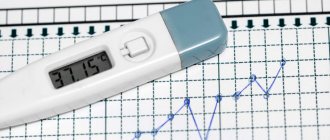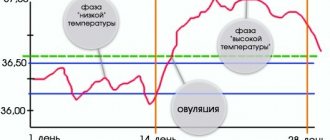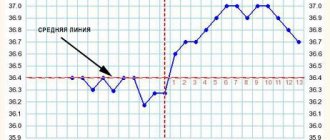Basal temperature is 37 or higher, what does it mean?
What does basal temperature mean and why does it change?
This is the temperature of a body in a state of complete rest and relaxation. This condition occurs in a person when he has rested for a long time in a lying position, and has never experienced mental stress. This is usually how a person feels after waking up in the morning, before getting out of bed. Doctors also call basal temperature rectal because it is usually measured in the rectum.
Normally, basal temperature varies between 36.4-36.8 degrees. Most often it rises during ovulation. In addition, basal temperature may increase if pregnancy occurs. An increase in the production of the hormone progesterone during these periods affects the body's thermostat, as a result of which body temperature rises. For example, if on one beautiful day the basal temperature is 37, this means that some changes have occurred in the body. When measuring temperature in the usual way, you may not notice this, which is why this method was invented. By the way, basal temperature is measured not only in the rectum, but also in the vagina and mouth, but rectal temperature is considered the most informative.
Why is basal temperature measured?
Mainly in order to study the menstrual functions of the female body. When your basal temperature rises, this may indicate that ovulation is approaching. Usually, on the day the egg is born, the temperature drops, and then rises sharply and remains until the start of the next menstruation. For this period, the normal basal temperature is 37.2-38.5. If the temperature remains unchanged throughout the entire cycle, then perhaps there was no ovulation, that is, it was an anovulatory cycle, which means that you need to look for reasons for this.
Basal temperature also rises at the beginning of pregnancy, and it remains approximately at the same level throughout the first trimester, and sometimes longer. If you measure your rectal temperature in the first 3-4 months of your pregnancy, you can monitor your pregnancy. If it gradually decreases, this may signal a possible miscarriage. During pregnancy, the basal temperature is within normal limits - 37.1-37.5 degrees. Deviation from this norm is a reason to consult a doctor. As you can see, measuring basal temperature can help many women avoid pregnancy-related problems.
How is basal temperature measured?
It is necessary to measure your temperature every morning for several menstrual cycles. We'll tell you why this is necessary. When measuring the temperature, which is measured while still in bed, it is undesirable to even move, that is, turn over or stretch, because this can add several tenths of degrees to the body. Therefore, you need to prepare a thermometer in advance. Try not to eat before bed and sleep at least 8 hours.
To obtain the most informative result, basal temperature must be measured at the same time for at least 5-7 minutes. It is advisable to use one thermometer every morning to avoid errors in the schedule. Daily temperature data must be entered into a special chart, thanks to which it will be possible to determine the exact time of ovulation in order to calculate fertile days, as well as determine “dangerous” days and even calculate the sex of the unborn child. But most often, women regularly take basal temperature measurements when they cannot get pregnant for a long time.
What can affect basal temperature readings?
Some factors, which we list below, can affect the basal temperature, which will prevent a woman from creating an ideal chart from which the necessary information can be determined. For example, while taking hormonal medications, you may not need to measure your basal temperature, because... it doesn't change at all. But besides this, there are several other reasons why the basal temperature can “lie”. These include the following:
- • Too short or restless, weak sleep.
- • Infectious diseases and inflammatory processes.
- • Sexual intercourse 3-4 hours before measuring temperature.
- • Consumption of alcoholic beverages, sleeping pills.
- • Stressful state, anxiety, feeling of anxiety.
What does basal temperature mean?
So, let's now find out what a change in basal temperature can mean. Many women wait for it to rise, but it happens that the wait does not justify their hopes. Therefore, women often write in the search bar: “basal temperature is 37, the test is negative”, “no basal temperature, but there is pregnancy” or “no temperature, but there is menstruation”, etc. Let's figure it out.
What does a basal temperature of 37 or higher mean? Most often, this may mean that you ovulated the day before. Further until the end of the cycle it will remain within 37.2-37.5 degrees. A basal temperature before menstruation of 37 and above (up to 37.5) is normal. By the end of menstruation, it gradually decreases and increases only after ovulation. But if during menstruation the temperature, on the contrary, rises, this may mean that you are developing endometritis - an inflammatory disease of the uterine lining.
A basal temperature of 37 or higher may mean you are pregnant. Therefore, if your basal temperature is 37 and the test is negative, do not rush to draw conclusions; perhaps you will see the two coveted stripes a little later. Continue measuring your basal temperature. If it does not subside, and at the same time you also have a delay in your periods, then, most likely, pregnancy has occurred.
Unfortunately, an increase in basal temperature can not only mean the onset of ovulation or pregnancy, but also signal some serious illness. Therefore, if you, say, have a basal temperature of 37.5 throughout the cycle, it means that something is wrong in the body, and you should consult a doctor. Fluctuations in temperature may also indicate a health problem. If yesterday you had a basal temperature of 37.4, and today it has become 38.4, and ovulation is still far away, and you know for sure that you are not pregnant, then you need to see a specialist for advice.
As you can see, basal temperature can tell us a lot. The main thing is to measure it correctly and not miss a single day, or rather morning. By drawing up a basal temperature chart, you can not only calculate the information you need - fertile days, ovulation, etc., but also control your women's health.
Natural test
Quite often, on the eve of ladies' days, girls discover that the thermometer shows an elevated mark. And at the same time, no other symptoms of the disease are observed. This can be explained by the fact that the expectant mother’s body reacts to the development of a new life. If the basal temperature after ovulation remains 37 - 37.4°, this means that conception has occurred. A basal temperature during pregnancy of 37 is quite acceptable. The acceptable threshold for increasing degrees varies from 0.1 to 0.4. Therefore, if there are no other health complaints, there is no need to panic. Such indications are the norm.
Basal temperature during pregnancy is 37: is this normal?
Please note that general temperature and basal body temperature are different concepts. And if an increase in the first type of temperature is a dangerous symptom, then in the case of the second, there is no concern. Often, in the early stages of an “interesting situation”, even before the onset of the next menstruation, the basal temperature during pregnancy will definitely reach 37 degrees. Sometimes this indicator can even rise to 37.5. That is, these could be indicators of a basal temperature of 37.1, and a basal temperature of 37.2 can also indicate an interesting situation. The female hormone progesterone, which is actively produced during this period, is to blame for this. Even if a basal temperature of 37.3 does not indicate pathology.
That is why, by measuring basal temperature, you can find out about pregnancy without special test strips. Gradually, the hormonal background of the expectant mother returns to normal. During this process, the basal temperature will become below 37 and pregnancy will develop further. As a rule, this occurs after the 21st week. However, it should be remembered that there should not be sharp fluctuations exceeding 0.1 to 0.4 degrees. This is a serious wake-up call. For example, if the basal temperature is 37.6.
If conception does not occur, the basal temperature chart can also tell you a lot. For example, if on all days of the cycle the basal temperature is 36-36.6 degrees, this indicates a malfunction of the hormonal system. If around the 17th day of the cycle and beyond the basal temperature does not rise to 37 degrees, this may be the reason that the egg is not in the process of maturation and will not be capable of successful fertilization in the future. If the basal temperature after ovulation is below 37°C, this most often indicates problems with ovulation, namely, insufficiency of the corpus luteum. In any case, you need to contact a gynecologist-endocrinologist.
Get a free doctor's consultation
Does basal temperature increase before menstruation?
Of course, because then significant changes occur in the body. Any deviation when the basal temperature rises may indicate disturbances in the body’s functioning.
If a woman is not pregnant and according to the results of diagnostic examinations she is healthy, then from the first day of the cycle the BT parameters are 36.4 - 36.8. If ovulation is about to occur, there is no increase in basal temperature: on the contrary, it drops slightly to 36. This phenomenon is called a drop in basal temperature: it occurs with an increase in estrogen levels.
Reasons for low basal temperature in the second phase
- Lack of progesterone. Determined by taking a test in the corpus luteum phase (7 days after ovulation);
- Anovulatory cycle. Determined by folliculometry.
- Incorrect BT measurements (change of thermometer, measurement location, time, illness in phase I, etc.);
- Other gynecological or endocrine diseases.
Note(!) Consultation with a specialist and examinations are required only when the situation with reduced BT in phase II is repeated for several cycles in a row. Single, non-repeating glitches on the chart are possible and do not pose any threat to potential pregnancy.
Pregnancy charts with low basal temperature
Let me remind you that you can talk about low BT if the graphs were kept for three or more cycles and the average temperature of the follicular phase is precisely known. And the difference between the two phases is 2.5° or less.
A normal pregnancy is possible with readings up to 37° and a relative difference of 3° and above. This is not considered a problem, but simply a feature of the body.
The following are BT graphs with a successful pregnancy and t° less than 37:
The basal temperature during pregnancy is below 37 degrees, but the difference between the phases is 0.4 degrees. Normal progressive pregnancy
Low basal temperature on a pregnant chart with ovulation relapse at 7 DPO
Basal temperature in phase I is 36.2 in phase II 36.7. The difference between the phases is 0.5 degrees. Pregnant schedule.
Important (!) If, with a confirmed pregnancy, a short-term drop in BT is possible. Do not panic and immediately start taking progesterone-containing drugs. They are prescribed only by a specialist. Watch yourself and make the right decision !
In this article I tell you how to understand a sudden drop in BT in the first phase, before ovulation and different periods after ovulation.
Elevated basal temperature: what does it mean?
The basal temperature of the cycle is of great importance in diagnosing the norm and pathology of its functioning.
When does basal temperature rise before menstruation?
If a patient’s basal temperature rises, this does not mean that her health is bad. Let's figure out why basal temperature is high, the reasons for its increase, and what is recommended to do in such cases.
What should you know about basal temperature? This indicator should be measured in a state of absolute rest after sleep, when the woman has not yet gotten out of bed. This temperature is not obtained in the armpit area, as we usually do with a cold or other pathologies, but in the mouth, vagina or rectum.
BT is very sensitive to all processes occurring in the human body. Its level is regulated by biologically effective substances - hormones.











